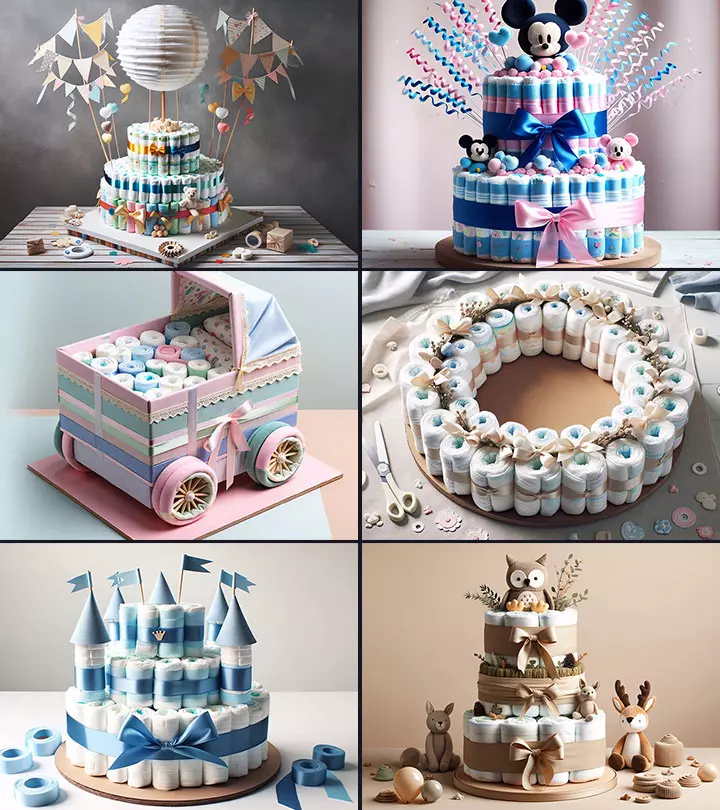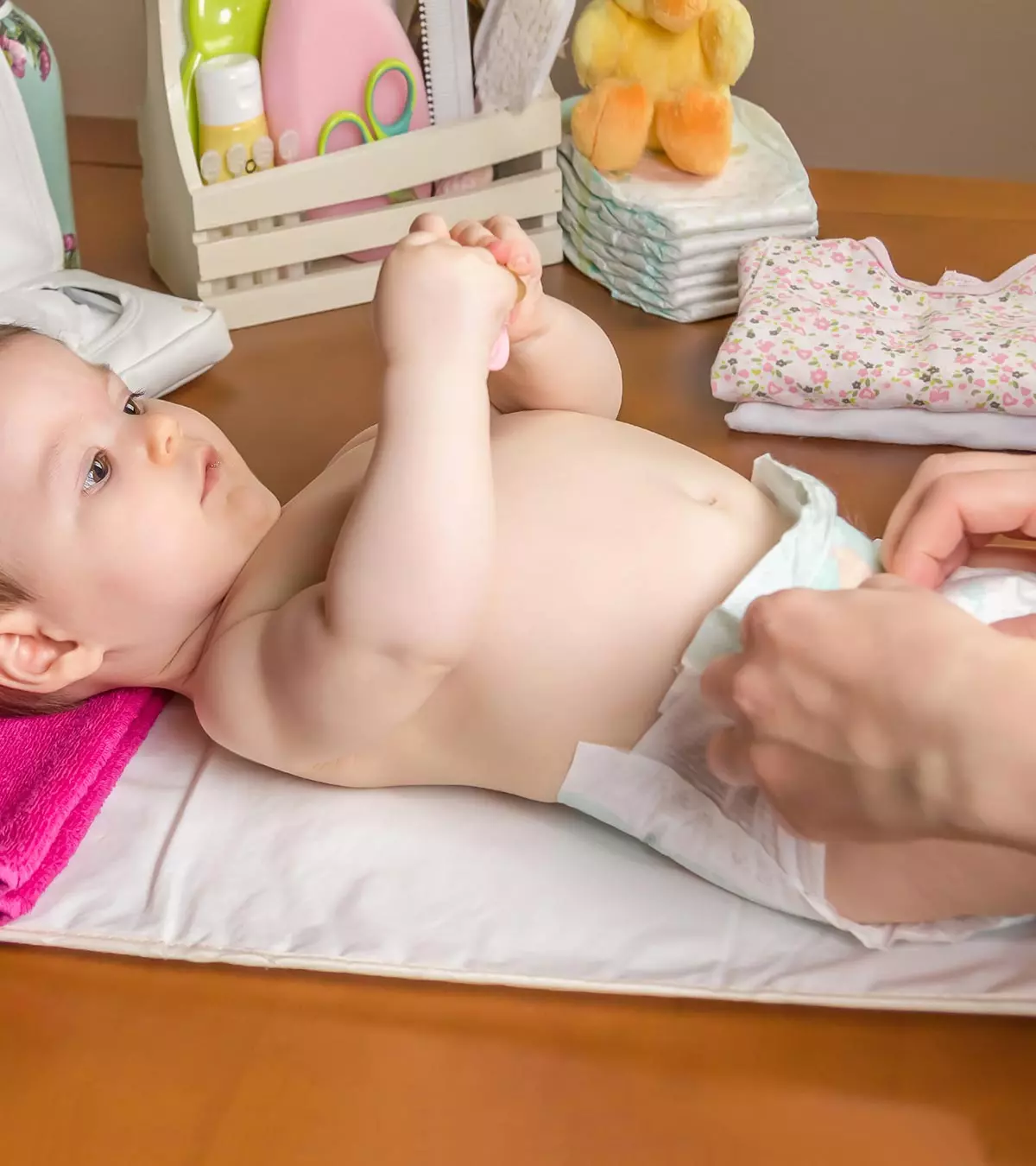
Image: ShutterStock
The transition of shifting your baby from bottle-feeding to a cup can be as difficult as it was for breastfeeding to bottle. So here we will tell you when to stop bottle feeding the babies to make the shift easier for you. Now that your baby is comfortable holding the bottle, they may not adapt swiftly to self-feeding from cups that easily. Read on to know about some useful tips that can help you in the process of weaning your baby from bottle feeding.

Key Pointers
- Prolonged bottle feeding can cause tooth decay and dental development problems in children.
- Bottle feeding can lead to excessive milk intake and pediatric obesity while reducing appetite for solid foods.
- Weaning from bottle feeding can commence at 12-14 months.
- Introducing sippy cups and solid foods can help reduce bottle feeding dependency.
- Diluting milk in the bottle can make milk in cups tastier for children, and help them break the bottle-feeding habit.
Why Should You Stop Bottle Feeding?
Here are a few reasons for stopping your toddler from bottle feeding.
1. Prolonged usage of bottles can lead to tooth decay.
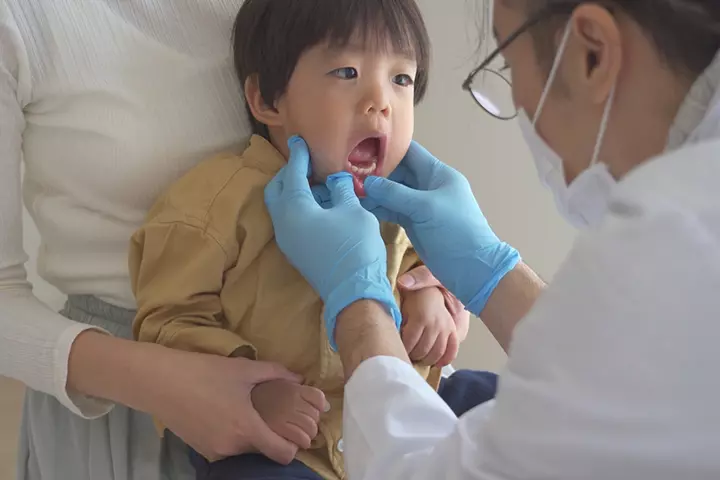
Toddlers tend to sip from the bottle throughout the day and night. Continuous sipping of milk, especially while sleeping, leads to tooth decay. As the toddler falls asleep while drinking, the milk pools in the mouth and creates an acidic cover on the teeth enamel, resulting in cavities.
2. It can lead to faulty dental development.
Continuous and prolonged sucking from the bottle nipple can impact the position of their adult teeth and the development of facial muscles in future (1).
3. Excessive usage results in pediatric obesity.
Most toddlers need about two cups of milk a day (2). However, bottle feeding results in excessive amounts of milk intake, much more than from a cup. Bottle dependency may lead your toddler to more likely put on excess weight and become obese. The CDC’s National Health and Nutrition Examination Survey 2017-2025 highlighted that childhood obesity affects 12.7% of children in the US between the ages of two and five years.
 Point to consider
Point to consider4. Lying down and drinking from a bottle can lead to infections.
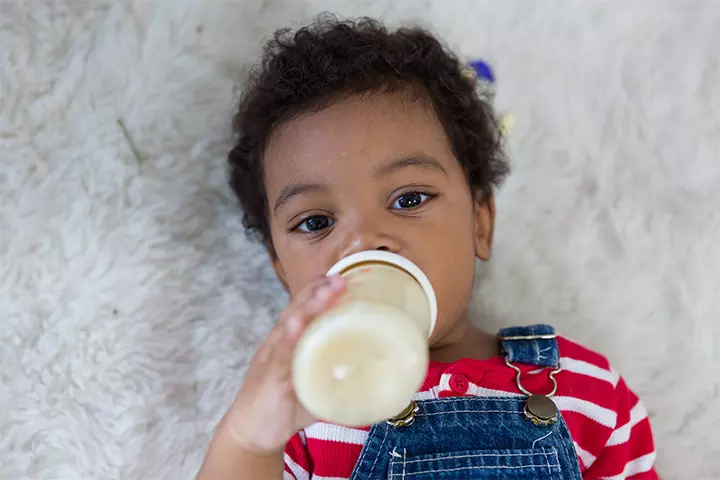
The milk that pools at the base of your toddler’s throat when they are busy sucking, becomes the home ground for breeding bacteria, resulting in a probable throat or ear infection in toddlers.
5. The toddler needs more solid foods.
As the toddler grows, the infant nutrition requirements also increase and cannot be met with just dairy intake. Solid and semi-solid foods such as cereals and pureed vegetables are essential for your child’s growth and development.
6. Your child is prone to get anemic.
If you are giving your child cow’s milk, an excessive amount can have a downside as their nutritional needs may not be met. Too much of cow’s milk with prolonged bottle usage can block the absorption of iron (3), which can make your toddler anemic.
Parents usually use bottle feeding as an intermediary between breastfeeding and cup feeding. If you have been breastfeeding your baby beyond one year, you can skip this intermediary level. But, if the baby has been drinking from a bottle since their early months, then you need to know when you can stop bottle feeding.
When Should You Stop Bottle Feeding?
You can start weaning the baby off the bottle from 12-14 months.
Around the end of the first year, you can try to stop bottle feeding your toddler and check if they are comfortable drinking milk from a small cup.
While this transition tends to be smooth and natural for some toddlers, who quickly start drinking from a cup, some parents may find it difficult to break the bottle habit.
Read on to know the techniques to stop bottle feeding for your toddler.
11 Ways To Stop Bottle Feeding Your Toddler
You can use the techniques listed below as-is or tweak them as you like.
1. Know when your child is ready to shift to a cup.

Your baby will develop the fine oral motor skills to hold and drink from a cup by the time they complete one year. They might also be naturally inquisitive and more open to trying out new things.
2. Make the switch gradually.
Relinquishing the bottle can be challenging for your toddler. Make the process slow and gradual. Initially, substitute one bottle feeding session with cup feeding, and reduce the bottle feeding sessions gradually.
 Things to know
Things to know3. Reduce the number of feeding times.
Bottle attachment is often a habit rather than a need for the toddlers. Therefore, come up with a feeding schedule to reduce the number of bottle feeding times by introducing solids. Solid food will keep the baby full for a longer time, thus cutting down on the use of a bottle. However, refrain from cutting back on the bed-time sessions initially as your toddler would be attached the most to bedtime bottle feeding.
4. Introduce sippy cups.
Sippy cups are great alternatives to feeding bottles. They are hassle-free, spill-proof and are easy to get used to. Also, the baby can hold the cup handles with both hands. Sippy cups interfere with normal oral development, and hence experts usually recommend soft straw as an alternative.
 Quick tip
Quick tip5. Dilute the milk in the bottle.
This age-old trick is still useful. Keep diluting the milk progressively when you give your child a bottle and offer them whole milk in a cup. Gradually, they will realize that the milk in the cup is tastier than that in the bottle.
6. Make the cup look interesting for the baby.

Grab your baby’s attention by adding colorful bendy or spiral straws to the cup, and making funny slurping noises. If they love the time spent while drinking, they will want to drink from a cup.
7. Go cold turkey.
If you have a stubborn toddler, who is resisting all your efforts, then refuse to give the bottle to them. Going cold turkey might seem cruel, but it is one of the fastest ways to boot the bottle. A sudden withdrawal, though painful, is useful in driving home the point that your toddler cannot have a bottle whenever they want to.
8. Let your toddler participate in the process.
If you have to go cold turkey, you can let them participate in the process. Let them pick up the toys they like when you give them a cup. If they feel involved, they are less likely to throw a tantrum for a bottle.
9. Reward your child.

Positive reinforcement at this stage is crucial. Whenever your child finishes milk in a cup, applaud them for that. You can introduce rewards like a toy or sing their favorite lullaby.
10. Find alternative ways of calming your child.
Sometimes, toddlers need physical intimacy and affection more than a bottle. Find other ways of affection like cuddling after they finish their cup or letting your partner take charge of mealtimes. Sometimes, a fresh face does the trick.
11. Introduce a stuffed toy or blanket at bedtimes
The bedtime bottle sessions are the hardest to get rid of. You can introduce a stuffed toy or blanket so that your toddler can snuggle with it after drinking from a cup. This way, they can substitute the comfort they get from sucking.
A little bit of parenting advice – this change won’t happen overnight, and you need to be patient while your baby throws tantrums and takes their time to gradually move away from a bottle. If nothing seems to be working, take a break for a few days and start all over again.
Frequently Asked Questions
1. What are the signs that indicate my baby is ready to stop bottle feeding?
You may wean off your baby from formula once they start taking a nutritionally balanced diet. However, it is advisable to make gradual changes to help your baby adjust to the diet and start replacing the bottle with a cup (6) (7).
2. Are there any benefits to bottle-feeding beyond a certain age?
There are no reports of benefits due to bottle-feeding beyond about 12 months of age. On the contrary, it may cause problems such as tooth decay and nutritional deficiencies.
3. How does switching from bottle-feeding to cup-drinking affect a baby’s oral development?
Switching from a bottle to cup between 12 and 18 months is associated with oral motor development which is important for eating table foods and speech development (8).
Infographic: Reasons To Wean Toddlers Off Their Feeding Bottles
Although bottle feeding your child can be a convenient option for you, this method may be more harmful than beneficial for your toddler. If you are finding it difficult to wean your child off their feeding bottles, this infographic will help you understand why you may need to stop. And here’s how.
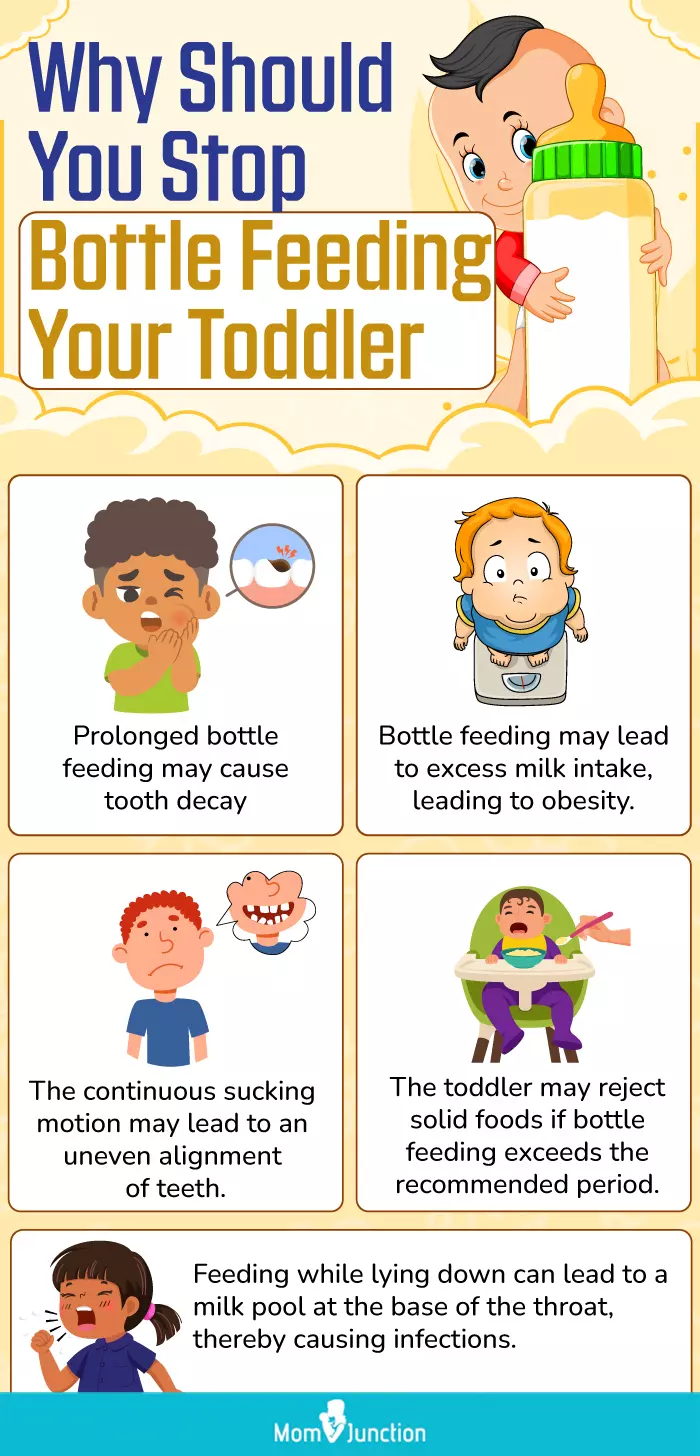
Illustration: Momjunction Design Team
Prolonged bottle-feeding can cause dental problems and nutritional deficiencies in babies. It can cause childhood obesity as well. Hence, you may stop bottle feeding the babies at about 12 to 14 months of age. Gradually transitioning to sippy cups while reducing bottle feed time is an effective way to induce weaning. Try rewarding the child for choosing options other than a bottle and using alternatives to soothe and calm them. You need to be patient during the change as it takes some time. Feel free to seek help from support groups or a pediatrician if required.
Illustration: When To Stop Bottle Feeding The Babies And How To Do It?

Image: Dall·E/MomJunction Design Team
Learn when to stop formula feeding your baby with this helpful video. Watch this video for important tips on when to start weaning and what milk to feed your child.
References
1. Hakan Ç, Çoruh T. D, Mehmet D, and Mehmet H ; Early childhood caries update: A review of causes, diagnoses, and treatments; J Nat Sci Biol Med. (2013 )
2. Toddlers and milk – how much is too much?; Growing Early Minds , Growing Early Minds
3. Steven B, and Kenneth L; Excessive Cow’s Milk Consumption and Iron Deficiency in Toddlers;ICAN: Infant, Child, & Adolescent Nutrition, (2009)
4. Stopping the Bottle; Nemours Kids Health
5. Introducing a Sippy Cup to Your Baby; Penn Medicine
6. How to Tell if Your Baby is Ready to Stop Drinking Formula; Cleveland Clinic
7. Weaning off the bottle; Raising Children
8. Transitioning from Bottle to Cup; Kennedy Krieger Institute
Community Experiences
Join the conversation and become a part of our nurturing community! Share your stories, experiences, and insights to connect with fellow parents.
Read full bio of Rebecca Koyf
Read full bio of Swati Patwal
Read full bio of Rohit Garoo
Read full bio of Anindita Ghatak








